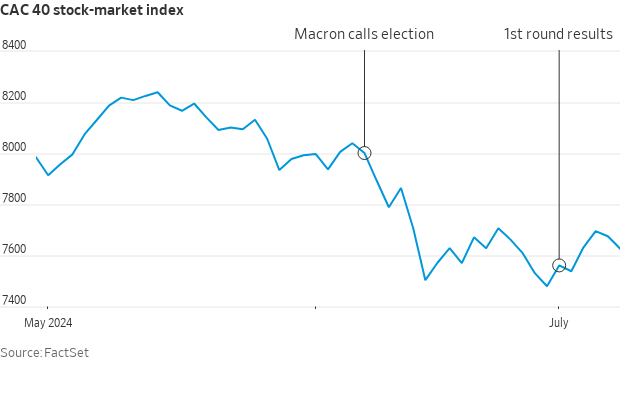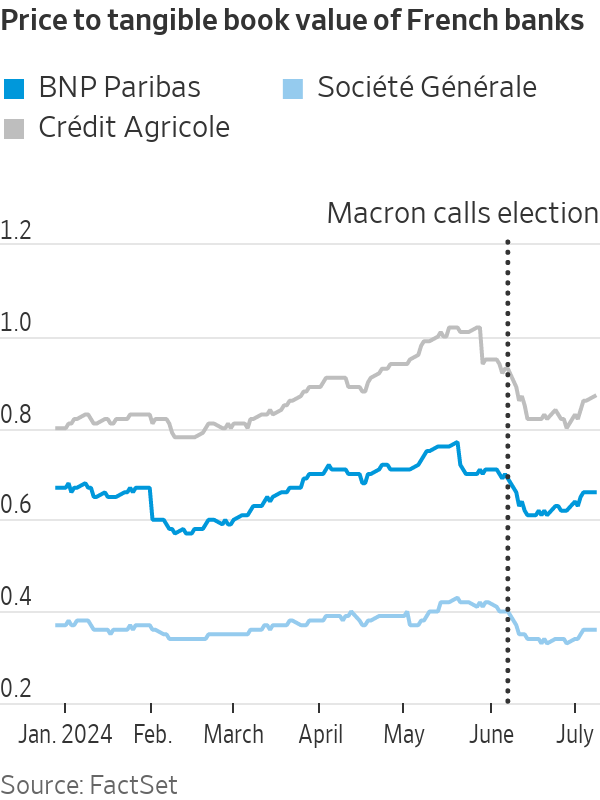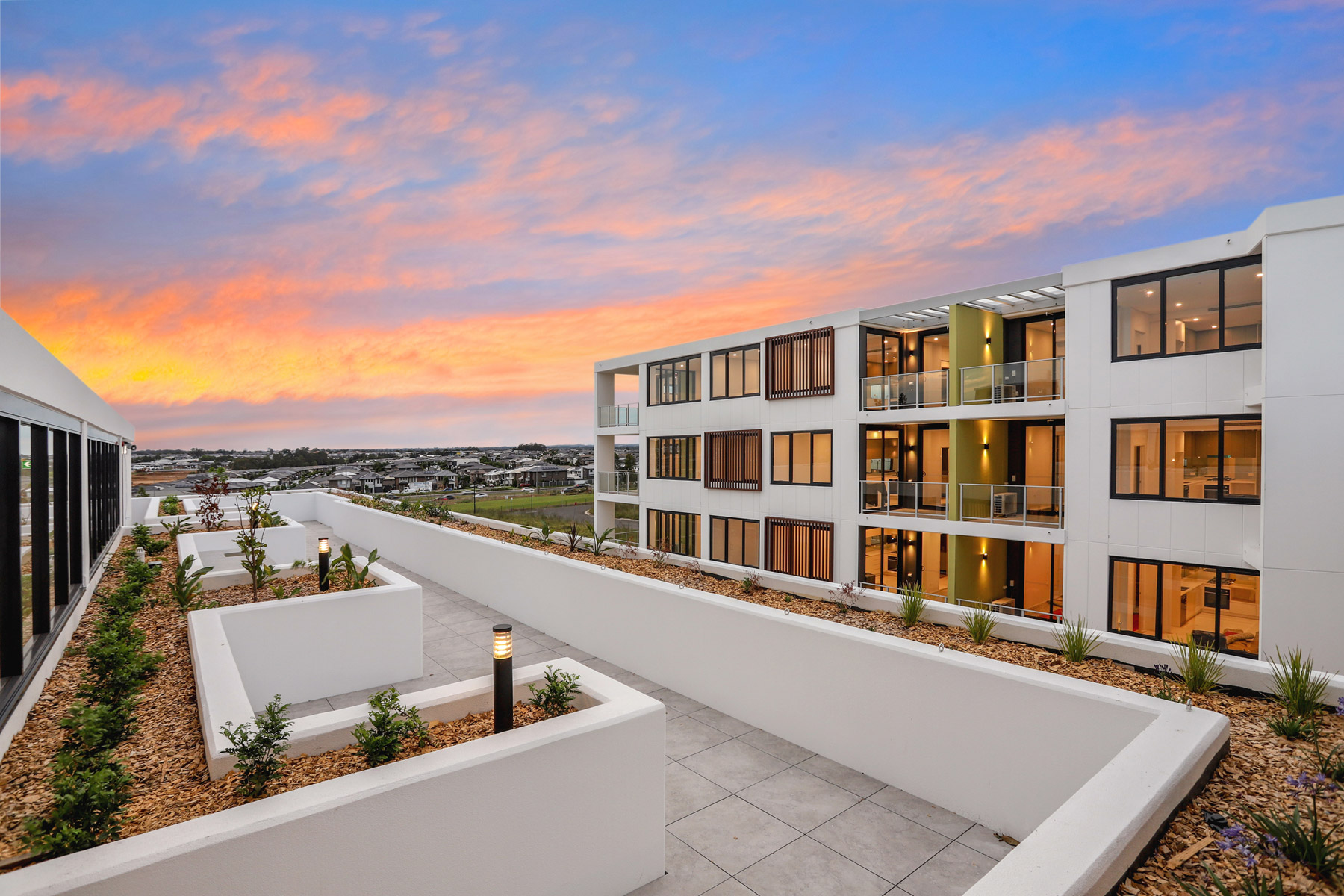In France, Investors Get the Centrist Limbo They Wanted
Polarisation has for years left the country’s politics stuck in an unpopular middle ground, and the latest elections won’t change that
When it comes to France’s turbulent politics , the current impasse is probably the best investors could have hoped for.
The second round of French legislative elections delivered a widely expected hung parliament, but not its predicted makeup: Rather than coming in first, Marine Le Pen ’s far-right and anti-immigrant National Rally finished third. In a shock twist , the leftist New Popular Front alliance emerged victorious, with the party of President Emmanuel Macron and its allies in second place.
This is because leftists and centrists ended up coordinating. In many local races, candidates dropped out to avoid dividing the vote against the far right. Still, no party has an outright majority, which plunges the country into political gridlock. This was, counterintuitively, the preferred outcome for financial markets.

The CAC 40 initially tumbled when the elections were called in June, driven by fears of a potential National Rally government challenging the European Union with fiscally expansive plans. Then the French stock benchmark perked up, as the first-round results suggested that the far-right wouldn’t get a majority.
Yet markets remained volatile because the rise of the New Popular Front raised even greater concerns. The policies of this coalition, in which leftist firebrand Jean-Luc Mélenchon is a key leader, also include more public spending, on top of widespread tax increases. Indeed, the CAC 40 closed down 0.6% Monday, probably reflecting investors’ concerns about these parties potentially managing to form a new government. Mélenchon has stated that there will be no deals with the centrists.
These worries seem overblown. Yes, there are doubts about how France will handle its budget deficit, which amounted to 5.5% of gross domestic product in 2023 and has forced the EU to launch an “excessive deficit procedure” against the country. Macron may need to accept the reversal of reforms such as a higher retirement age.
Still, a fiscal crisis isn’t in the cards, because the European Central Bank is ultimately in control of France’s bond market.
As for economic growth, it is unclear how much impact Macron’s policies have had in the first place, particularly given resistance from unions and swaths of the public, which resulted in the famous “yellow vest” protests in 2018 and 2020.
What matters for sectors battered in the stock market, including banks, energy firms and infrastructure operators, is that the risk of widespread tax increases, nationalisations and a prolonged standoff with Brussels seems smaller now than a few weeks ago. Whatever Mélenchon says, the left will either have to compromise or else form a minority government that might scare investors but wouldn’t be able to pass laws.

So there isn’t much justification for the lower valuation of lenders such as Société Générale and especially BNP Paribas —one of Europe’s most interesting banks that now trades at 0.65 times tangible book value. The same is likely true for firms such as energy utility Engie and infrastructure-concessions leader Vinci , which have lost 8% of their market value since the end of May.
These elections are more a symptom of Macron’s weakness than its cause. After a chaotic month, French politics is back where it has been for years, with a rising far right forcing the left to back a centrist platform that can achieve little because few people actually like it. Macron himself became president on an anti-Le Pen ticket, but in seven years has failed to rally broad support for his pro-business vision.
This could eventually make Le Pen’s victory inevitable, as she claimed after initial results came in. For now, though, it is more or less what markets ordered.
 Copyright 2020, Dow Jones & Company, Inc. All Rights Reserved Worldwide. LEARN MORE
Copyright 2020, Dow Jones & Company, Inc. All Rights Reserved Worldwide. LEARN MORE
A divide has opened in the tech job market between those with artificial-intelligence skills and everyone else.
A 30-metre masterpiece unveiled in Monaco brings Lamborghini’s supercar drama to the high seas, powered by 7,600 horsepower and unmistakable Italian design.
A divide has opened in the tech job market between those with artificial-intelligence skills and everyone else.
There has rarely, if ever, been so much tech talent available in the job market. Yet many tech companies say good help is hard to find.
What gives?
U.S. colleges more than doubled the number of computer-science degrees awarded from 2013 to 2022, according to federal data. Then came round after round of layoffs at Google, Meta, Amazon, and others.
The Bureau of Labor Statistics predicts businesses will employ 6% fewer computer programmers in 2034 than they did last year.
All of this should, in theory, mean there is an ample supply of eager, capable engineers ready for hire.
But in their feverish pursuit of artificial-intelligence supremacy, employers say there aren’t enough people with the most in-demand skills. The few perceived as AI savants can command multimillion-dollar pay packages. On a second tier of AI savvy, workers can rake in close to $1 million a year .
Landing a job is tough for most everyone else.
Frustrated job seekers contend businesses could expand the AI talent pipeline with a little imagination. The argument is companies should accept that relatively few people have AI-specific experience because the technology is so new. They ought to focus on identifying candidates with transferable skills and let those people learn on the job.
Often, though, companies seem to hold out for dream candidates with deep backgrounds in machine learning. Many AI-related roles go unfilled for weeks or months—or get taken off job boards only to be reposted soon after.
Playing a different game
It is difficult to define what makes an AI all-star, but I’m sorry to report that it’s probably not whatever you’re doing.
Maybe you’re learning how to work more efficiently with the aid of ChatGPT and its robotic brethren. Perhaps you’re taking one of those innumerable AI certificate courses.
You might as well be playing pickup basketball at your local YMCA in hopes of being signed by the Los Angeles Lakers. The AI minds that companies truly covet are almost as rare as professional athletes.
“We’re talking about hundreds of people in the world, at the most,” says Cristóbal Valenzuela, chief executive of Runway, which makes AI image and video tools.
He describes it like this: Picture an AI model as a machine with 1,000 dials. The goal is to train the machine to detect patterns and predict outcomes. To do this, you have to feed it reams of data and know which dials to adjust—and by how much.
The universe of people with the right touch is confined to those with uncanny intuition, genius-level smarts or the foresight (possibly luck) to go into AI many years ago, before it was all the rage.
As a venture-backed startup with about 120 employees, Runway doesn’t necessarily vie with Silicon Valley giants for the AI job market’s version of LeBron James. But when I spoke with Valenzuela recently, his company was advertising base salaries of up to $440,000 for an engineering manager and $490,000 for a director of machine learning.
A job listing like one of these might attract 2,000 applicants in a week, Valenzuela says, and there is a decent chance he won’t pick any of them. A lot of people who claim to be AI literate merely produce “workslop”—generic, low-quality material. He spends a lot of time reading academic journals and browsing GitHub portfolios, and recruiting people whose work impresses him.
In addition to an uncommon skill set, companies trying to win in the hypercompetitive AI arena are scouting for commitment bordering on fanaticism .
Daniel Park is seeking three new members for his nine-person startup. He says he will wait a year or longer if that’s what it takes to fill roles with advertised base salaries of up to $500,000.
He’s looking for “prodigies” willing to work seven days a week. Much of the team lives together in a six-bedroom house in San Francisco.
If this sounds like a lonely existence, Park’s team members may be able to solve their own problem. His company, Pickle, aims to develop personalised AI companions akin to Tony Stark’s Jarvis in “Iron Man.”
Overlooked
James Strawn wasn’t an AI early adopter, and the father of two teenagers doesn’t want to sacrifice his personal life for a job. He is beginning to wonder whether there is still a place for people like him in the tech sector.
He was laid off over the summer after 25 years at Adobe , where he was a senior software quality-assurance engineer. Strawn, 55, started as a contractor and recalls his hiring as a leap of faith by the company.
He had been an artist and graphic designer. The managers who interviewed him figured he could use that background to help make Illustrator and other Adobe software more user-friendly.
Looking for work now, he doesn’t see the same willingness by companies to take a chance on someone whose résumé isn’t a perfect match to the job description. He’s had one interview since his layoff.
“I always thought my years of experience at a high-profile company would at least be enough to get me interviews where I could explain how I could contribute,” says Strawn, who is taking foundational AI courses. “It’s just not like that.”
The trouble for people starting out in AI—whether recent grads or job switchers like Strawn—is that companies see them as a dime a dozen.
“There’s this AI arms race, and the fact of the matter is entry-level people aren’t going to help you win it,” says Matt Massucci, CEO of the tech recruiting firm Hirewell. “There’s this concept of the 10x engineer—the one engineer who can do the work of 10. That’s what companies are really leaning into and paying for.”
He adds that companies can automate some low-level engineering tasks, which frees up more money to throw at high-end talent.
It’s a dynamic that creates a few handsomely paid haves and a lot more have-nots.
Now complete, Ophora at Tallawong offers luxury finishes, 10-year defect insurance and standout value from $475,000.
On October 2, acclaimed chef Dan Arnold will host an exclusive evening, unveiling a Michelin-inspired menu in a rare masterclass of food, storytelling and flavour.























